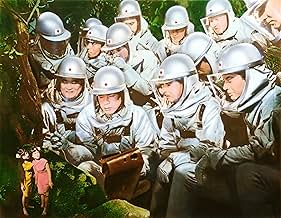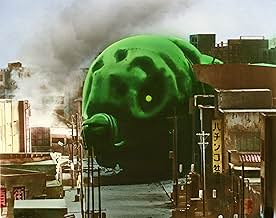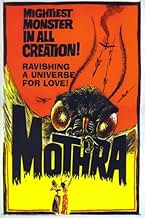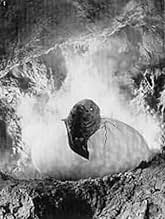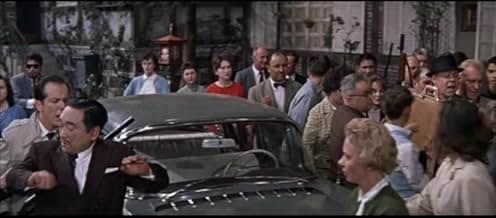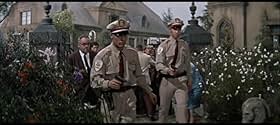An expedition to Infant Island uncovers a native tribe and twin tiny fairy priestesses of a mythical deity, who sets out to rescue the pair after they are kidnapped by a greedy businessman.An expedition to Infant Island uncovers a native tribe and twin tiny fairy priestesses of a mythical deity, who sets out to rescue the pair after they are kidnapped by a greedy businessman.An expedition to Infant Island uncovers a native tribe and twin tiny fairy priestesses of a mythical deity, who sets out to rescue the pair after they are kidnapped by a greedy businessman.
- Awards
- 2 nominations total
- Shobijin (Twin Fairy)
- (as Yumi Ito)
- Shobijin (Twin Fairy)
- (as Emi Ito)
- Kurâruku Neruson
- (as Jerî Itô)
- Military Advisor
- (as Yoshibumi Tajima)
- Nelson's Henchman
- (as Hiroshi Iwamoto)
- Ship Survivor
- (scenes deleted)
Featured reviews
The colors are bright. The story is strange. Mothra doesn't appear until halfway through the movie. The tiny singers are the strangest cinematic creations and that's in the same movie as Mothra. There is a lot of miniature and green screen work. This is a classic Japanese monster movie.
A greedy showman/explorer Clark Nelson (Jerry Ito) finds twin fairies on an island off Japan. He displays them on the Tokyo stage, where they sing what sounds like a lullaby. It is actually a telepathic distress call to their god and protector, Mothra, a giant caterpillar. Mothra comes to Tokyo, searching for the girls and Nelson, destroying most of the city in it's path. The chase goes from Tokyo to Newkirk City (I guess this is suppose to be a little real life hamlet just south of Yonkers!) What I really love about MOTHRA is that it has many things most other monster movies don't. The hero is a comical, older, tubby reporter, a sort of Japanese Lou Costello. The monster is actually pretty. In the Japanese version, there is some wonderful slapstick and odd humor. THese elements make this film so unique. Director Inoshiro Honda was best friends with more famous and more respected Japanese director Akira Kurosawa. Kurosawa loved Honda's monster movies and according to rumor, yearned to make one himself.
1961's Mothra runs pretty evenly, allowing the story to breathe adequately before dishing out some modest mass destruction. The film's first acts, with scientists exploring Infant Island, remind me greatly of Skull Island from King Kong; the manner in which they use the fairies as a sideshow is not too far off from Kong either, only instead of unleashing a giant monkey's wrath, the fairies sing and summon a giant larva. It's weird stuff, but the film plays everything out with a straight face. This film ultimately sets the pattern for future incarnations of Mothra (you seriously can't have Mothra without the singing fairies, the larva, or without specific phases of attacks). As the original feature, however, the only formula this film adheres to is that of the classic monster picture, with a bit of adventure thrown in, and it's neat that way.
The story's pretty much outlined above; it is a well-structured plot with a cast of alright (and sometimes goofy) characters. With all the fairies and monsters on display, I always felt that Mothra was a grade more unbelievable than most other monster movies, but thanks to the film's earnest tone, it works as a fine and dandy fantasy (and it's pretty neat to see such fantasy being opposed by modern and ultramodern weaponry). The story touches upon a few themes concerning capitalism and greed, but is never overbearing.
This film uses solid, quality photography and editing. Acting is good from the original cast (but might be marred heavily by the English dubbing if you chose to watch it). Writing gets the job done pretty well. This production shows its age, but still uses fine-looking sets, props, and costumes. Special effects are a bit rough, but for its time, they are smashing. Music is not bad either.
No matter how silly or fantastic it gets, I have a soft spot for Mothra, especially in seeing her future clashes with Godzilla and other monsters. The first and most original Mothra film presents the basics of Mothra-lore, which in turn echoes parts of the original King Kong, and would stand proudly next to classic monster flicks like Godzilla. Fans of the genre should give this original film a rent.
4/5 (Entertainment: Good | Story: Pretty Good | Film: Good)
Did you know
- TriviaThe Mothra larva was the largest costume Toho would create in the Showa era. The Mothra larva seen rampaging through Tokyo's neighborhood was about 7 feet tall and just over 31 feet long. Weighing about 265 pounds (120 kilograms), a total of eight actors were needed to perform and operate the Mothra larva.
- GoofsWhen Dr. Shinichi is showing the symbols he discovered in the cave to Senchan, you can see someone in black pants and shoes walking down the stairs behind Senchan's head.
- Quotes
[the protagonists confront Nelson to return Mothra's fairies back to Infant Island]
Dr. Shinichi Chujo: I want you to stop this inhumanity and return them to their island.
Nelson's Henchman: Inhumanity? Ridiculous. Strictly speaking they're just scientific data.
Clark Nelson: Those fairies aren't human. They're merchandise.
- Crazy creditsIn the credits for the U.S. version, including promo material released by Columbia Pictures, Eurasian model Jerry Ito (who plays the villianous Mr. Nelson) is billed as "Jelly Ito."
- Alternate versionsThe American Version also edited the birth of Mothra sequence, cutting out a good 40 seconds to make it more elaborate
- ConnectionsEdited into Invasion Planète X (1965)
Details
- Release date
- Country of origin
- Languages
- Also known as
- The Thing
- Filming locations
- Tokyo, Japan(Studio)
- Production company
- See more company credits at IMDbPro
Box office
- Gross worldwide
- $90
- Runtime1 hour 41 minutes
- Sound mix
- Aspect ratio
- 2.35 : 1
Contribute to this page




